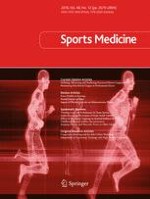01-12-2018 | Original Research Article
Modeling the Benefits of Cooperative Drafting: Is There an Optimal Strategy to Facilitate a Sub-2-Hour Marathon Performance?
Published in: Sports Medicine | Issue 12/2018
Login to get accessAbstract
Background
During a race, competing cyclists often cooperate by alternating between leading and drafting positions. This approach allows them to maximize velocity by using the energy saved while drafting, a technique to reduce the overall drag by exploiting the leader’s slipstream. We have argued that a similar cooperative drafting approach could benefit elite marathon runners in their quest for the sub-2-hour marathon.
Objective
Our aim was to model the effects of various cooperative drafting scenarios on marathon performance by applying the critical velocity concept for intermittent high-intensity running.
Methods
We used the physiological characteristics of the world’s most elite long-distance runners and mathematically simulated the depletion and recovery of their distance capacity when running above and below their critical velocity throughout a marathon.
Results
Our simulations showed that with four of the most elite runners in the world, a 2:00:48 (h:min:s) marathon is possible, a whopping 2 min faster than the current world record. We also explored the possibility of a sub-2-hour marathon using multiple runners with the physiological characteristics of Eliud Kipchoge, arguably the best marathon runner of our time. We found that a team of eight Kipchoge-like runners could break the sub-2-hour marathon barrier.
Conclusion
In the context of cooperative drafting, we show that the best team strategy for improving marathon performance time can be optimized using a mathematical model that is based on the physiological characteristics of each athlete.





